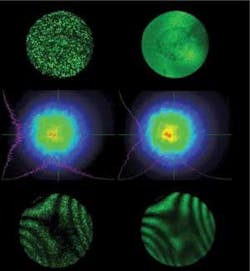Laser speckle, rather than sensor resolution or an optical system’s diffraction limit, can be the limiting condition of performance in applications including metrology, interferometry, microscopy, lithography, tomography, and projection displays. In late 2008, Dyoptyka (Dublin, Ireland) announced that it was supplying evaluation kits for its speckle-reduction technology. Less than a year later, after filing several patent applications, Dyoptyka is able to disclose some of its techniques, and plans to launch its commercial speckle-reduction products at Laser 2009 in Munich.
High-frequency deformations of a mirror surface modulate wavefront curvatures to significantly vary ray angles within the illumination beam. Dyoptyka uses a single low-voltage piezoelectric ceramic actuator to vibrate a thin plate of reflective-coated glass, metal, or plastic. Resonant modes of vibration allow deformation of the mirror surface relative to the motion of the actuator. An electronic control system, which can operate at up to 200 kHz, randomizes the vibrations such that a sequence of uncorrelated speckle patterns is formed. The reduction in speckle achieved is proportional to the number of uncorrelated speckle patterns averaged over the exposure period. When used in different optical-system designs, the high-frequency deformable mirror can act to reduce temporal coherence, spatial coherence, or both. In addition, speckle granularity and contrast can be dynamically controlled as well as minimized. Contact Fergal Shevlin at [email protected].
About the Author
John Wallace
Senior Technical Editor (1998-2022)
John Wallace was with Laser Focus World for nearly 25 years, retiring in late June 2022. He obtained a bachelor's degree in mechanical engineering and physics at Rutgers University and a master's in optical engineering at the University of Rochester. Before becoming an editor, John worked as an engineer at RCA, Exxon, Eastman Kodak, and GCA Corporation.

